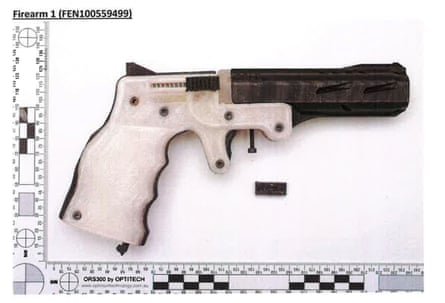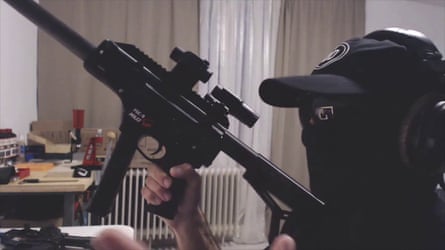In 2023 a Canberra mechanic was servicing a grey BMW when he made a startling discovery. Under the seat he found a handgun.
The pistol looked strange. It was made almost entirely of plastic – half white, half black.
The mechanic didn’t know it but the car belonged to a street-level drug trafficker who’d come down from Sydney seeking “fast money” slinging meth across Canberra’s suburbs.
The gun had been made by an associate with a 3D printer, according to court documents. It was untraceable and lethal, and part of a trend that experts say threatens to fundamentally upend Australia’s world-leading gun controls.

Andrew Hemming, an expert in criminal law at the University of Southern Queensland, says the laws on 3D-printed firearms are a “dog’s breakfast”.
Manufacturing or possessing any type of firearm without a licence is illegal across Australia but specific laws on 3D printing vary between the states.
Some have criminalised the manufacture of 3D-printed weapons or owning blueprints while others rely on existing firearm laws.
Hemming says the united action Australia took to tighten gun laws after the 1996 Port Arthur massacre, in which 35 people were murdered, is now coming undone.
How did Australia change its gun laws after the Port Arthur massacre?
ShowAfter the 1996 mass shooting in Port Arthur that killed 35 people, the Australian government enacted the national firearms agreement.
The deal between the federal and state governments aimed to make gun laws broadly uniform across states and territories. It introduced mandatory licensing, rules for secure storage and use, and restrictions on semiautomatic rifles and pump action shotguns.
There was a buyback scheme for guns that were now classed as illegal. Australians could voluntarily give up weapons in exchange for financial compensation – leading to the surrender of more than 600,000 firearms.
Owners would also need a “genuine reason” for having guns, such as hunting or sports shooting, and personal protection was not a valid reason. The agreement specifically states that firearm possession is a privilege, not a right.
This sets Australia apart from other countries, most notably the United States, where a right to bear arms is included in its constitution. US Congress and state legislatures have passed some gun control measures, including mandated background checks but, unlike Australia, most states have not banned assault weapons.
Gun ownership in the UK is also considered a privilege, not a right, and new laws have similarly responded to mass shootings, including the 1987 Hungerford massacre. Certain semiautomatic rifles were banned and police must consider reasons for ownership before issuing a licence.
The effectiveness of Australia’s gun control measures remain a matter of debate, and some elements are yet to be fully enacted almost 30 years later, including the nationwide firearms register.
“We all got together after Port Arthur and everybody pulled together with the ban [on some semi-automatic and pump-action firearms] and the buyback,” he says.
“Well, the reality is … if anybody can make one, the sands have shifted and it’s only a question of time.”
More sophisticated and more lethal
The firearm found in Canberra resembled images of a popular 3D-printed pistol model known as the Harlot, court documents say. According to numerous online communities that celebrate and promote 3D-printed guns, the Harlot is entry-level.
Sign up: AU Breaking News email
“It’s quick, and cheap to print, easy to assemble, and the hardware required to complete the build is readily available,” one website hosting instructional material says.
But more reliable and more deadly models are now showing up.
Det Supt John Watson, commander of the drug and firearms squad in New South Wales police state crime command and the head of the national illicit firearm working group, says police have been uncovering 3D-printed weapons for more than a decade.
Over the past three to four years the trend has been from “very novice, very low-powered, almost a one-shot weapon” to higher-quality weapons, he says.
In 2025 police say they have so far made seizures of homemade firearms in almost every state and territory.
In one suburban home police allege they found 3D printers as well as 3D-printed pistols, magazines and firearm parts.
The stash allegedly included a 3D-printed semi-automatic carbine in parts, commonly known online as the Urutau.
The blueprints of the Urutau were released online only last year but already components have allegedly been found during police raids in multiple states.
In another case, police allegedly found a “Nutty 9” firearm – a spin-off of the FGC-9 – and a 3D-printed pistol as well as the digital blueprint for the manufacture of firearms.
Images released by police show a vast array of components allegedly found during the raid, including an incomplete Urutau.
Gun parts in the post
Rajan Basra, a researcher at King’s College London, says the 3D-printed gun world has become a “social movement”.
The Urutau and other models, including perhaps the most infamous 3D-printed firearm, the FGC-9 – or “Fuck Gun Control” – emerge from online communities that share information and promote the creation of weapons both as a means to push the boundaries of science and, according to some designers, “permanently undermine global firearm prohibition”.
after newsletter promotion
The Urutau was intentionally designed without the need for regulated parts in some countries – all “with basically [online retail] stuff”, as the man behind the gun’s design said on a podcast in May.
An open letter that accompanies the build kit online promotes “the unlimited right to keep and bear arms”.
On Discord servers and filesharing websites, this community posts memes and gun rights quotes alongside long lists of projects and links of recommended retailers for buying build kits as well as barrels and parts that cannot be reliably 3D printed.
In one case, Australian Border Force allegedly intercepted several shipments sent from China. The packages were allegedly described as “pipes” or “high pressure oil pipe”, according to court documents. Police allege they were “unfinished firearm barrels”.
Some groups promote what they call a “new second amendment”, according to Dr Yannick Veilleux-Lepage, an associate professor at the Royal Military College of Canada. Broadly, this is the belief that the right to bear arms is universal, not just part of the US constitution.
“This all falls within the same movement, which is essentially trying to push the boundaries of privately manufactured firearms,” he says. “The main impact here is the erosion of state control on firearms.”
Worried? ‘Build one yourself’
It’s unclear how many 3D-printed guns are being seized in Australia each year – there is no centralised record – yet an examination of court documents suggests various models are emerging, created both by hobbyists and those intending to use them for criminal purposes.
In 2023 a man was sentenced in Melbourne for possessing a traffickable quantity of firearms, six of which were 3D-printed handguns, court documents show, including 0.22 rimfire calibre pistols, as well as aggravated carjacking, among other charges.
Some suggest 3D-printed firearms may not be popular among cohorts linked to organised crime, because of a lack of reliability and their aesthetic. “They communicate to other people that you’re not able to source a conventional firearm,” Veilleux-Lepage says.
But this could change. Some popular models, such as the “Not-a-Glock”, he says, look like a conventional firearm and are cheap to build.
Extremist groups that might not otherwise be able to easily access the illicit market also pose a threat.
“Over the last few years … it’s very typical for the gun blueprints to be shared by far-right influencers, along with the instructional material and incitement for followers to make guns at home,” says Basra, who unmasked the man behind the FGC-9 as the already deceased German citizen Jacob Duygu.

Artem Vasilyev was sentenced to at least three years in jail in the South Australian supreme court in 2024 after pleading guilty to more than a dozen firearm offences.
In his sentencing remarks the judge referred to a report prepared by a forensic psychologist, which said Vasilyev “was in the process of becoming radicalised” and had material “espousing extremist rightwing ideologies” on his electronic devices.
The court heard that a plastic tub containing 3D-printed gun parts that could be used to make a FGC-9 firearm was found in his home.
In a NSW hearing about whether to put in place an extended supervision order, the court heard how a man who had shared extremist beliefs was found to have downloaded hundreds of 3D-printing files for a number of firearms.
Urutau’s anonymous originator, who goes by the handle Joseph the Parrot, was asked on a podcast this year about extremists using his design.
“I mean, I don’t support them but if they build a gun I can’t do anything about that,” he said.
“If you are upset about a white supremacist building a Urutau, you can build one yourself to counter him.”

 3 months ago
49
3 months ago
49

















































